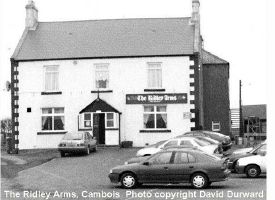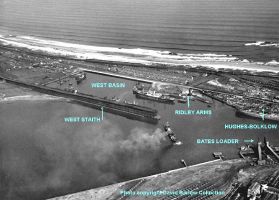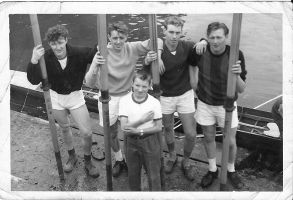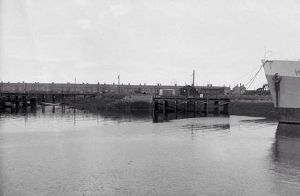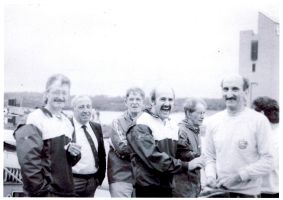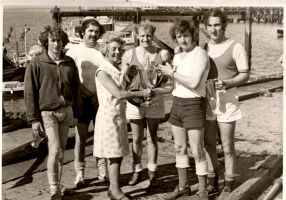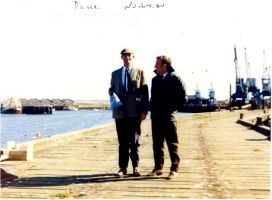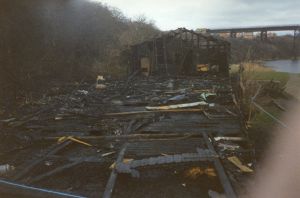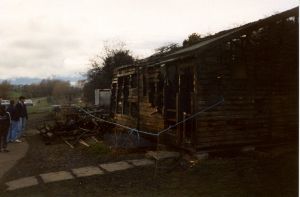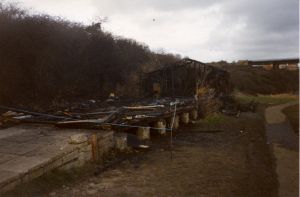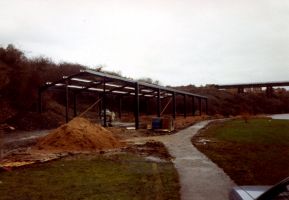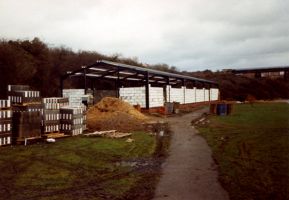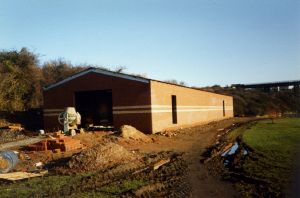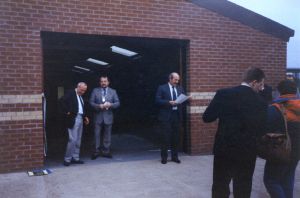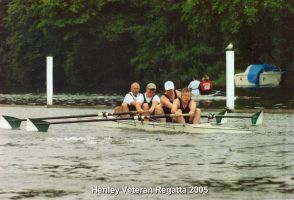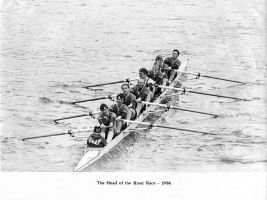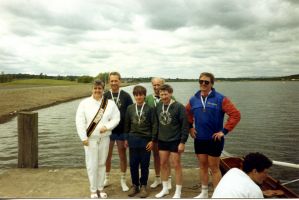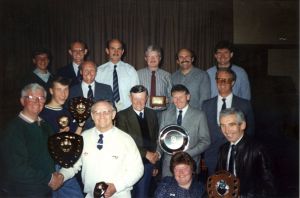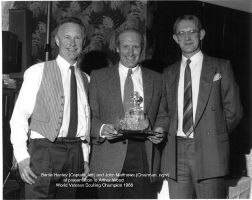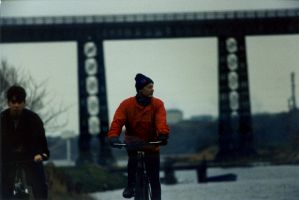Cambois Rowing Club
Early Days
Cambois Rowing Club has a long and rich history in the local community. Founded by a group of miners in 1911 as the Wansbeck Rowing Club, the rowers were classed as professionals (as opposed to 'amateur' or 'gentlemen'). The Club paid competitors' entry fees and travelling expenses but all winnings had to be paid back to the Club and added to the funds. This was significantly different to other professional Clubs, where monetary prizes could usually be kept by the rowers. Being from a mining background, it was not unusual for Cambois rowers to arrive at regattas on the back of a coal lorry, covered in coal dust!
The club was initially aimed at improving the health of miners, and miners contributed 3 pence per week to a community welfare fund which helped fund the activities. The club started out on the banks of the River Wansbeck, using a disused railway carriage as the members' changing rooms. The first club meeting only attracted four members but with enthusiasm and their first boats the Anthony and the Cleopatra, described as "twice as long as normal boats and a beam as wide as the Queen Mary", they grew to thirty in number within a fortnight.
In the years 1912 and 1913 the Club won the professional fours handicap at the prestigious Durham Regatta, John Wheatley (who later had a boat named after him in 1948) being the stroke man in 1912 , and in 1913 the stroke was Harry White. The year 1912 followed a miners coal strike and the Committee were adamant that dues must be paid, threatening to expel those members behind with their dues.
In 1919 two matched boats were ordered from Aylings of Putney at a cost of £35 each.
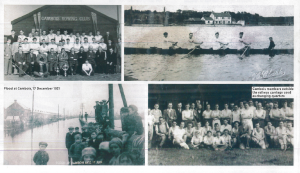
1920/1930s
The austerity of the 1920s and 30s played some part in the demise of rowing in that era. Ian Wrigglesworth, in his book The Social History of English Rowing, comments that the 1926 General Strike "endangered the very existence of some Northern clubs such as those at Blyth and Cambois". Members of the club had been excused subscriptions until the strike ended, but the lack of income must have had a detrimental effect on the club's viability. Throughout the country, many works-supported clubs had folded during the depression of the 1930s. The Wansbeck club, however, survived. An unusual but interesting fact is the club added to their portfolio of activities in 1920 by starting a male voice choir, under the conductorship of Mr. J. Moralee, A.L.C.M. as well as taking part in soccer matches.
In 1925 the Club added to their fleet with the delivery of two new fours, the "Robert Wheatley" and "The Wansbeck"
In 1934 electricity had still not been available to light the boathouse and an oil lamp on loan from the British Legion was apparently being used to add illumination. However, in response to a demand from the British Legion, the Secretary was instructed to write and apologise for the non-return of the oil lamp!
Move to River Blyth (1931)
In 1931 the club relocated to the River Blyth, to Wheatley's Ferry Point, a site made available by Robert Wheatley, a prominent Club member over the years. The site is where the power station was later built and it was two years later, in 1933, that the club name changed to Cambois Rowing Club to reflect the new location. In the early days, no steps were available so davits and a winch were used to lower the boats to the water.
When the Blyth Power Station (now the site of British Volt) plans were announced in 1954, the club had to relocate once again by moving 600 metres downstream to a site adjacent to the Ridley Arms (affectionately nicknamed the Willock) near Battleship Wharf, on the River Blyth. Just to the south of the Ridley Arms was the Hughes Bolcow-shipbreaking yard and to the north were the huge wooden staithes were such a predominant feature of the film 'Get Carter'.
It appears that in 1937 billiards was becoming very popular at the Clubhouse and as matches were stretching into the night, no doubt a distraction affecting the rowers performances, the Committee took a firm hand and ruled that billiards must cease at 10pm !
Back to the River Wansbeck (1977)
In 1968, the miners' levy, which had supported the Club in such a fine way, ceased due to the closure of Cambois Colliery. The club relocated back to the mid-reaches of the River Wansbeck to Black Close Bank in 1977, when the erection of a grain silo threatened the clubhouse. This was coincidental to a dam, along with landscaping works, being built near the A189 road bridge near the Wansbeck estuary, and a grant from the Sports Council enabled a new wooden boathouse to be built.
The Club would sometimes use a bus for travelling to regattas and Barrie Hanley recalls "The clubhouse roof was the same height as the bus roof so it was a simple task to pass the boats over to the roof of the bus, to be tied down for the journey. However, one day we arrived at York Regatta and we couldn't get on top of the bus to offload, so we had to borrow boats from other clubs to compete!"
1980s to 2000
In 1992, the club hit rock bottom when the wooden boathouse was subject to an arson attack and everything was lost. The building and all the boats were turned to ash, resulting in £50,000 of damage. Most boats were insured, but the Clubhouse was not. Only one boat survived: the Aylings eight named 'The Octopus'. A fund-raising effort was commenced to raise £75,000 to build a brick boathouse.
The club has come a long way from travelling to regattas on the “back of a coal trailer” and arriving for the race "covered in coal dust”, but is proud of its roots and visitors to the boat house can view club photographs adorning the walls upstairs which date back quite some time.
Blyth Rowing Club ceased to operate in 1985 and the few remaining members of Blyth RC, in particular the renowned Pearson family, continued to row at Cambois RC. Here is an interesting BBC Look North feature on the club and of the Pearson brothers:
2000 onward
The Club has continued to be successful in the 21st century, especially in respect of junior rowing. Jamie Kirkwood of Cresswell rowed for Great Britain and won gold in the U23 World Championships at Brest in 2010. He also won the Visitors Challenge Cup at Henley Royal Regatta in 2010 and 2011. Elaine Johnstone represented Great Britain at the World Championships in Poland.
Newspaper references
18th November 1876
The Morpeth Herald reported:
On Saturday a handicap skiff race, promoted by the Wansbeck Rowing Club, was brought off at Cambois, on the Wansbeck. The club gave as first prize a splendid silver cup, with 10 shillings for second and 5 shillings for third. The heats resulted as follows:—First heat —R. Wheatley, scratch, 1; S Henderson, 3 lengths, 2. Second heat.—J. Houliston, 7 lengths, 1; J. Richardson, 3 lengths, 2. Third heat—J. M. Gray, 1 length, 1 ; W. Brown, scratch, 2. Fourth heat —W. Prike rowed over. Fifth heat— H. Marshall bye. Second ties: First heat.—R. Wheatley, 1; J. Houliston, 2. Second heat— Gray, 1; Prike, 2. Third ties—Wheatley, 1; Marshall, 2. Final heat—Gray, 1; Marshall, 2. The distance was half-a-mile - out and in.
1st April 1920
The Blyth News reported:
The annual meeting of the Wansbeck Rowing Club was held on Friday night In the Mechanics' Institute. Cambols. Mr. William Taggart presided, and his opening remarks were appropriate to the occasion. The record of the club during the year had been enhanced by defeating the Walker Rowing Club on the River Tyne for the Oxo Challenge Cup, and the record of the individual oarsmen in the Tyne Christmas Handicap was also very encouraging. James Drysdale and Harry White having been left in the last eight and four respectively. In regard to the financial position, the report on the years transactions showed the income to be (£105 2s 9d and the expenditure £96 16s 1d, leaving a credit balance of £8 6s 8d. The greatest outlay had been for two new boats, which they had purchased recently. The report was accepted as very satisfactory, which proved to be the best year financially they have had. The election of Officers and Committee for the ensuing year resulted as follows:, President. County Coun. J.W. Hogarth: chairman, Mr Joseph R. Nichol; secretary, Mr James Morris, treasurer, Mr Henry White; captain Mr James Drysdale: Vice-captain. Mr Arthur Thirlwell; Committee: Messrs David Hudspith, Edward Hall, C. Lavender, Wm. Taggart, James Drysdale. Arthur Thirlwell, John Drysdale and Thos. Marshall.
18th October 1920
The Blyth News reported:
The Wansbeck Rowing Club have commenced a male voice choir, under the conductorship of Mr. J. Moralee, A.L.C.M. and is making considerable progress.
25th June 1925
The Blyth News reported:
TWO NEW BOATS - Prospects of Wansbeck Rowing Club. A pleasing ceremony was performed at the mouth of the river Wansbeck on Saturday afternoon. when the Wansbeck Rowing Club launched two new four-oared boats. Mr. Joseph Nichol presided and Mr. Geo. Sparks named the boats, one "The Robert Wheatley" and the other "The Wansbeck." In a few appropriate remarks Mr Sparks said that the members of the club were justified in naming a boat after Mr Robert Wheatley. Mr Sparks advised all rowers to learn to swim in case of accident. He also gave a resume of the doings of the club, and said the Wansbeck Club had won the Durham Regatta in 1912 and 1913, two years in succession—a very meritable performance. He wished them every success with their new boats and hoped the young men would benefit by them. Mr D. Etringham moved a vote of thanks to those who had officiated. He said there were always good rowers among the miners. He had not been long at Cambois but he had seen some young men who with practice would make good rowers. Mr W. Taggart seconded the vote thanks. A jumble handicap afterwards rowed out and was witnessed by a large crowd of people. Winter and Watson's crew won.
Also in 1925, Cambois RC competed in the North Seaton Rowing Club Regatta in 1925, winning the Coxed Fours event by beating Stakeford Rowing Club in the final.
10th June 1926
The Blyth News reported:
A keen and interesting football match took place in the Welfare Park at Cambois on Monday night, the opposing sides being players chosen from the Cambois Silver Band and the Wansbeck Rowing Club. Mr J. D. Etringham officiated as referee. Mr J. D. won the toss and Mrs Brown, of Cambois Farm kicked off. During a melee in the goalmouth Thompson scored for the Rowers, Hopper scoring a second goal after a corner, a third following shortly after. After the interval Harland scored twice from penalties for the band. The same player added a third also from a penalty, thus completing the hat trick. The game ended shortly afterwards, the result being three goals each. The game was thoroughly enjoyed by about 200 spectators. The feature of the game was the fine defensive work of Harland. Marshall played well as pivot. and Edwards was the best forward on the field. The Rowing Club were best served by Hopper, Hudspith and Tommy Thirlwell. A collection was taken during the game, the proceeds to be devoted to a special fund.
6th March 1933
The Shields Daily News reported:
OARSMEN BEARERS - There was a large attendance at the funeral of Mr Edward Taggart, of Boathouse Terrace, Cambois, who died on Wednesday last. Taggart was a member of the Cambois (Wansbeck) Rowing Club and coxswain for the Wansbeck crews at the Durham Regatta for the past three years. The funeral took place at Cowpen Cemetery, and eight rowers of the club acted as bearers. Deceased leaves a widow and two children.
16th July 1934
The Blyth News reported:
CAMBOIS WIN - Organised by the North Seaton Rowing Club as an annual event, a £20 professional four-oared handicap was decided over a half-mile course on the River Wansbeck at North Seaton, yesterday. A satisfactory entry of 25 crews. The final results were: Cambois (M.Turnbull, N.Robinson, J.Gibson, G.Spratt) beat Cambois (T.Thirlwell, J.Todd, E.Drysdale, S.Drysdale) by a 1/4 length.
28th June 1948
The Blyth News reported:
CAMBOIS RC BOATS NAMED - Nearly three hundred people attended the christening of two new four-oared strake boats at Cambois on Sunday afternoon. Built of cedar and representing the last word in the builders art, they arrived from the famous yard of T. Sims of Oxford, the maker of most of the boats that have competed in the Oxford & Cambridge Univ. races for the greater part of a century. Recalling the history of Cambois R.C., Mr Nichol told the company of early feats which have established a reputation that remains unshaken to this day. Known originally as the Wansbeck Rowing Club, this body of enthusiasts grew from an attendance of four at the first meeting. Within a fortnight of the inception, membership had risen to 30. "All we had was an old boat - the Cleopatra - which was about twice as long as the new ones, and had a beam nearly as wide as that of the Queen Mary", Mr Nichol continued, amid laughter. Despite its drawbacks, this ancient craft served its purpose until better boats could be found. Regatta wins in 1912 - within a year of the coming into being of the Club' - John Wheatley (now home on holiday from America and present at the ceremony) "stroked" Cambois to win the Durham Regatta event. This performance was repeated in 1913 by Harry White, whose name is borne by one of the latest boats. Mr Nichol expressed the hope that the new additions to the Cambois Rowing Club would prove their worth. If these boats had as long a life as those they were succeeding, then he felt that after 27 years there might be little more than the names left. However, although Mr White and himself might by then have passed from the scene, it would be a grand thing if the answer to any who asked who Harry White and Joseph Nichol were was "Just a couple of the pioneers" (Applause.) Mr George Sparks presided. Among those who were present were Coun. and Mrs J. Payne, Bedlington: Coun. J.Pattison. Bedlington; Captain C.W. Walker, Blyth Harbourmaster; Mr Harry White; Mr G. Hutchinson and Mr R.S. Elliott (Cambois Welfare); Mr M. Cowal. Chairman of Cambois Social Club and Mr J. Hudspeth, Cambois. The design of the new boats was prepared by Mr J. Nevens. Cambois Colliery engineer, and follows faithfully that of their previous boats, the Wansbeck and Robert Wheatley. After the christening. a 'jumble' handicap race was run between the West Staiths and Battleship Wharf, following which tea was served to members and guests in the clubroom.
23rd September 1948
The Blyth News reported:
WON OWN REGATTA - North Seaton Rowing Club's regatta held on the River Wansbeck on Saturday and Sunday, was won by one of its own crews. stroked by G. Warnaby. They were off nine and in the final defeated Blyth (D. Pearson) off ten. Defeated semi-finalists were two Cambois crews, stroked by M. Turnbull (scratch) and T. Sharp (eight).
23rd May 1952
The Morpeth Herald reported:
FORMER STAKEFORD MAN STROKES WINNING CREW - North Seaton Rowing Club were defeated by four lengths by Tyne United in the final the Northern Amateur Rowing Trials on the River Tyne on Saturday. By this defeat North Seaton were deprived of the opportunity of representing the Tyne in a contest with a club, Barnes Amateur, in the London Clubs Regatta on 8th June. The contest will be held for the first time since the war. The Tyne club was stroked by a former Stakeford man, W. Kennedy, who was a member of the Cambois crew, stroked by Matt Turnbull, when they were winners of the Durham Handicap in 1947 and 1949. The North Seaton crew, which usually rows over a half-mile course, felt the strain of the course, between Scotswood Bridge and Newcastle Corporation Quay, which is over the mile. The North Seaton crew was stroked by R. Rees and other local clubs, Cambois and Blyth, competed.

